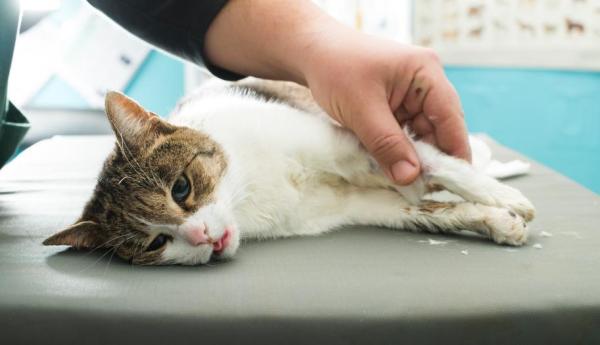Feline Leukemia Virus - Contagion, Symptoms, Diagnosis And Treatment



See files for Cats
Feline leukemia is a disease caused by feline leukemia virus (FeLV), which suppresses a cat's immune system. This virus directly target’s a cat’s white blood cells, resulting in a decrease of defenses. The feline leukemia virus puts a cat at a higher risk of contracting infections and additional complications.
Feline leukemia is common in cats around the world and can be lethal, especially if not treated and/or detected in time. It cannot, however, be transmitted to humans. For more about the symptoms, diagnosis, treatment and life expectancy of feline leukemia, keep reading here at AnimalWised.
Leukemia in cats
What is feline leukemia? Feline leukemia is caused by the feline leukemia virus (FeLV), a retrovirus otherwise refered to as onco-virus or onvogenic RNA virus. Onco-viruses cause various immunological, degenerative and even proliferative conditions. They can appear as endogenous or exogenous. When exogenous, they are capable of replicating during FeLV transmission, as is the case of feline sarcoma virus (FeSV), a type of malignant tumor that occurs in soft tissues.
There are four subgroups within FeLV. However, practically all infected cats are infected by the FeLV-A. The feline leukemia virus subgroups are characterized by:
- FeLV-A: is the original form of the virus, (mutated forms can be developed).
- FeLV-B: predisposes the feline to suffer from neoplasms (abnormal tissue growth).
- FeLV-C: associated with the development of erythroid hypoplasia and severe anemia.
- FeLV-T: predisposes a cat to infection and destruction of T lymphocytes.
The subgroups can be detected and diagnosed through different tests, which we mention below. For more about FeLV and FIV we recommend reading our article where we discuss everything you need to know about feline AIDS.
Feline leukemia: contagious
The feline leukemia virus is spread predominantly during cat pregnancy, either through the uterus or during a cat’s lactation period. FeLV can, however, also be transmitted through bodily fluids such as saliva, urine, blood or nasal secretions. A healthy cat can also be exposed to the virus through mutual grooming, sharing the same litter box, food bowls or external (bleeding) wounds.
All cats are susceptible to catching the feline leukemia virus, however, kittens and young cats are more vulnerable. This is especially the case when a domestic cat (especially male), that has not been neutered or vaccinated, has access to the outdoors. FeLV is also more common in homeless and feral cats that do not have access to the necessary treatments or preventative methods.
When the feline leukemia virus comes into contact with a cat’s immune system, one of three possibilities may occur:
- The cat is immune and has created sufficient antibodies to cope against the virus. This results in characteristic FeLV symptoms which remit after a few weeks.
- The virus enters a cat’s blood and saliva, thereby damaging the immune system resulting in feline leukemia. In this case, the feline is susceptible to various diseases and life expectancy is immediately reduced.
- The virus is eliminated through the blood and saliva but persists to the bone marrow. Although it reactivate, the most frequent occurrence is that it does not affect the feline.
So, ‘‘Is leukemia in cats contagious?’’ Yes, leukemia among cats is contagious and extremely dangerous. Prevention is key in making sure a cat does not contract the feline leukemia virus.
Feline Leukemia: transmission to humans
According to recent studies the feline leukemia virus is not a zoonotic disease. Therefore, feLV cannot be transmitted to humans.

Feline leukemia: symptoms
Feline leukemia in cat symptoms can vary depending on the cat’s general health status.
The most common symptoms of leukemia in cats include:
- Fever
- Fatigue
- Anemia
- Decrease in appetite
- Lethargy
- Inactivity
- Drowsiness
- Weight loss
- Seizures
- Difficulty recovering from illnesses
- Skin lesions
- Renal problems
- Respiratory symptoms- sneezing
- Gastrointestinal disorders
- Fatigue
- Weakness
- Anorexia
- Diarrhea
- Lymph node swelling
- Stomatitis (mouth inflammation)
- Gingivitis
- Bacterial infections
- Viral infections
- Jaundice
- Coat thinning
- Lack of cleanliness
- Stop using the sandbox
- Hypothermia
- Pain
- Loss of teeth
- Dehydration
Feline leukemia: diseases
As we’ve already mentioned, cats suffering from the feline leukemia virus become susceptible to various diseases. The most common include:
- Anemia in cats
- Feline lymphoma
- Spinal lymphoma
- Fibrosarcoma
- Multiple cartilaginous exostoses
- Feline gingivostomatitis
- Feline Lymphoid leukemia
- Progressive infections
- Immunosuppression in cats
- Immunodeficiency
- Oncogenicity (tumors in cats)
- Systemic vasculitis
- Glomerulonephritis in cats
- Polyarthritis in cats
- Bone resorption
- Fetal death
- Placental regression
- Miscarriage in cats
- Bacterial endometritis
- Fadding kitten syndrome
- Enteritis in cats
- Peripheral neuropathy in cats
- Urinary incontinence in cats
- Anisocoria in cats
- Mydriasis (pupil dilation in cats)
- Horner’s syndrome in cats
- Blindness
- Feline Calicivirus
Keep reading to find out how to detect feline leukemia.

Feline leukemia: diagnosis
If you have observed one or several of the aforementioned symptoms, we recommend consulting your veterinarian as soon as possible in order to confirm a diagnosis. A professional will perform a feline leukemia test with a complete blood count. This test is commonly performed after adoption, before vaccinations and in the case of FeLV exposure.
FeLV tests include:
- ELISA (enzyme-linked immunosorbent assay): a typical test carried out at veterinary clinics. A blood sample is collected from the cat, from which it is detected whether there is the presence of antigens and/or early stages of feline leukemia virus. In order to know whether or not the virus is temporary or permanent, one will have to wait a few weeks.
- PCR (Polymerase chain reaction): detects virus DNA in affected cells (either in blood samples or in other tissues). Although it can detect latent infections, it is not as informative as ELISA.
- IFA (immunofluorescent assay): this test is not useful for early-stage detection but can confirm a positive ELISA result. It detects the presence of antigens in infected cells.
It is possible that, if the test is negative, your veterinarian may suggest re-doing the test after 30 days, specifically in the case that transmission is high. In addition, if your cat has access to the outside, we recommend performing this test annually. In the case of a positive result, a veterinarian will most likely perform additional tests and analysis.

Feline leukemia: treatment
It is very important to note that feline leukemia has no cure.Certain individuals, however, can lead a normal life as long as they receive regular veterinary care which includes the administration of antivirals and immunoregulators. So, if you’re asking yourself, ‘‘Should a cat with feline leukemia be put down?’’ Absolutely not! A cat with FeLV can live a somewhat normal life!
In order for a cat to live a healthy life with FeLV, you will need to make sure that your cat receives:
- High quality feed.
- Environment free of stress.
- Excessively hygienic environment: make sure to keep your cat’s litter box, food and water bowls etc. clean (daily).
- Necessary vitamins.
- Feline leukemia treatment.
Most importantly, you will also need to prevent your cat from infecting other cats. This can be done by keeping your cat indoors and making sure your cat has been neutered/spayed. You may be wondering, ‘‘Can a cat with feline leukemia live with other cats?’’ Cats who carry the feline leukemia virus can only live with cats that also have FeLV or animals of another species.
If, however, you do have other kittens or cats in the house, make sure they are vaccinated and are separated from your infected cat. This separation is necessary as the feline leukemia vaccination is not 100% effective.

Feline leukemia virus: vaccine
When it comes to feline leukemia prevention, you have to make sure your cat has been vaccinated. Be sure to follow your cat’s vaccination schedule strictly. In addition, make sure to test for FeLV before adopting any cat, especially if you already have a cat in the home.
For more, we suggest taking a look at our article where we list the most common diseases in cats.

Feline leukemia: life expectancy
How long do cats live with leukemia? A cat’s leukemia prognosis can vary and depends largely on a cat’s individual case. There is a high mortality rate when it comes to feline leukemia, however, some cats can live to 10-15 years, while others has a significantly short life expectancy.
This article is purely informative. AnimalWised does not have the authority to prescribe any veterinary treatment or create a diagnosis. We invite you to take your pet to the veterinarian if they are suffering from any condition or pain.
If you want to read similar articles to Feline Leukemia Virus - Contagion, Symptoms, Diagnosis And Treatment, we recommend you visit our Viral diseases category.











